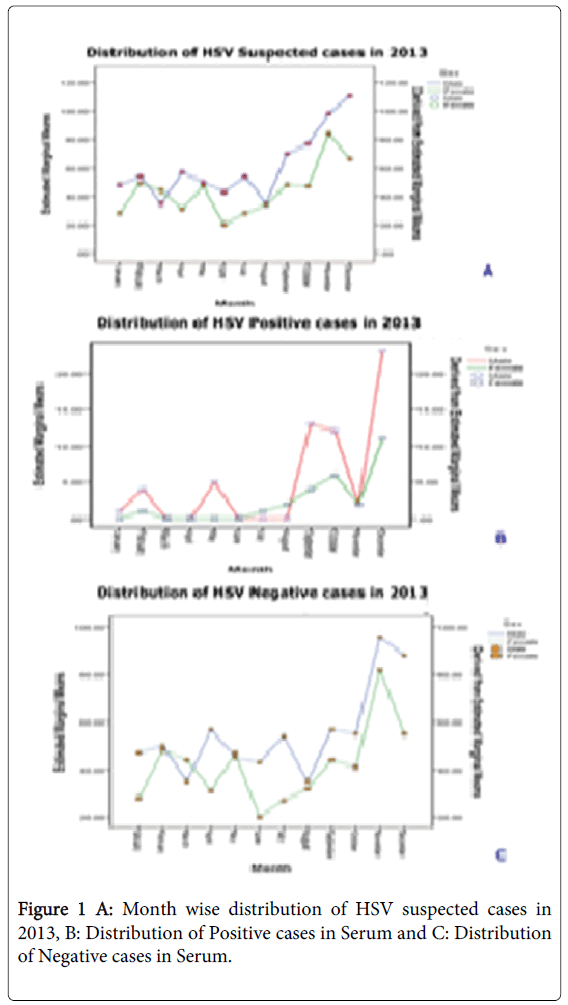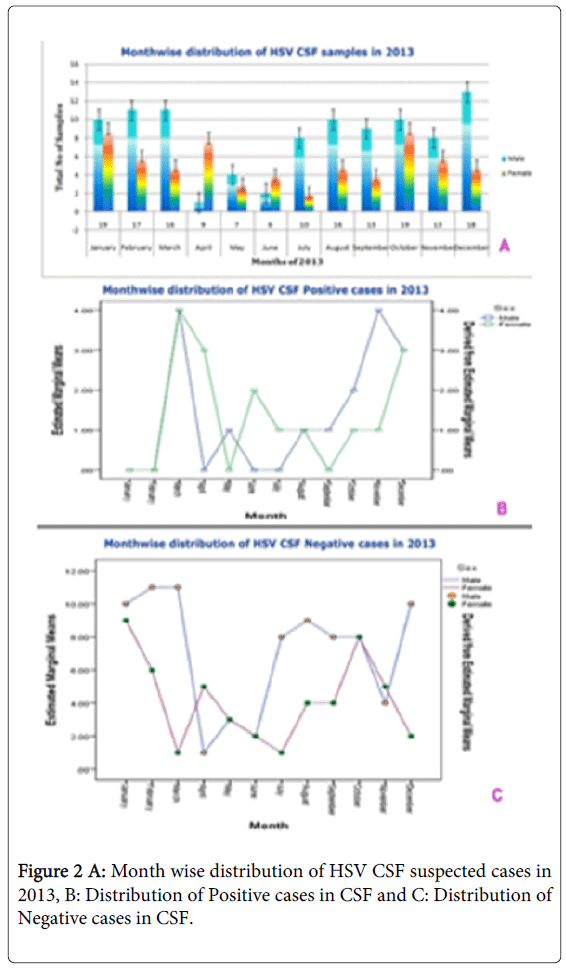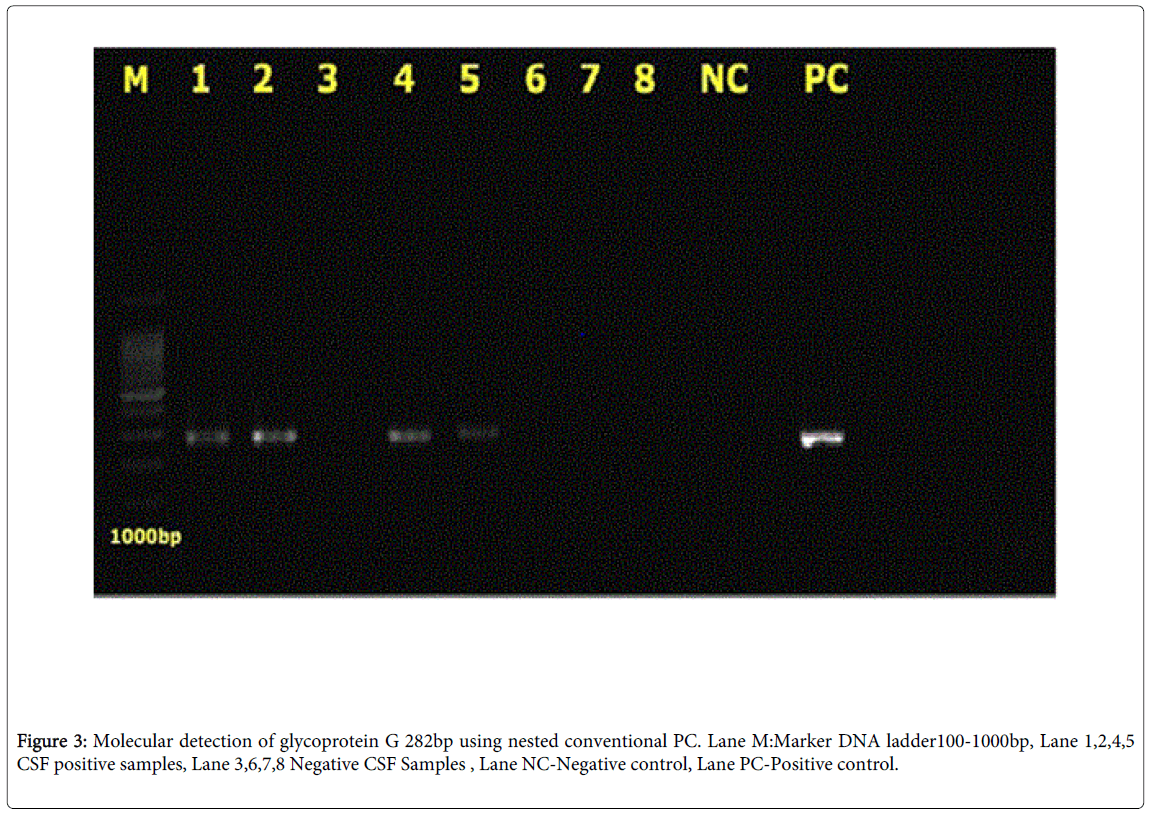Epidemiological Studies and Molecular Characterization of Herpes Simplex Virus among Urban Population in Chennai, Tamilnadu
Received: 28-Apr-2015 / Accepted Date: 23-Jun-2015 / Published Date: 27-Jun-2015 DOI: 10.4172/2161-1165.1000187
Abstract
Background: Herpes infections were caused predominantly by sexually transmission diseases. Especially the Herpes simplex viruses 1 and 2 appear in many parts of the body. Dermatologists were difficult to diagnose the infections, they can identify after performing blood and CSF tests. Prevalence of age and sex of herpes infections is important to optimize for herpes control strategies. Therefore the study was conducted to assess the epidemiological and molecular characteristics of Herpes Simplex Virus in the northern districts of south India, Tamil Nadu, Chennai.
Methodology: Samples from the northern districts of south India, TamilNadu, Chennai were accounted for the study. A total of 1244 serum and 163 CSF samples were examined for the prevalence of HSV from January 2013 to December 2013. Seroprevalence of the HSV was detected using the commercial IgM ELISA in study area. The positive samples were then subjected for Nested Polymerase Chain Reaction in CSF samples. The data were collected by and analyzed by statistical software using SPSS version 20.
Results: Neonates (0-1yr) showed higher positivity for HSV infection. The statistical analysis revealed that the Male gender were ranges from 0-12yrs were highly susceptible for the HSV infection and above 12yrs were poorly susceptible and month wise data showed higher prevalence was in november and december. The HSV nested PCR were performed and it was developed as marker for the molecular diagnosis for HSV infection. 282 bp of glycoprotein gene was amplified and it was characterized to detect the HSV in CSF samples.
Conclusion: Herpes simplex virus infection in the northern districts of South India reveals that the male populations have significant prevalence than the female gender. Further the neonates with 0-1yr age indicate higher positivity. This finally concludes that the transmission HSV from mother to fetus occurs significantly high.
Keywords: Herpes Simplex Virus; ELISA; PCR; Epidemiology and Molecular Characterization
163283Introduction
Herpes virus (HSV) is an important human pathogen cause sexually transmitted disease [1,2]. Herpes simplex viruses are associated with the severe symptoms of ulceration in the organs. Furthermore the serious clinical symptoms were keratitis, neonatal infection and facial palsy. The major cases were associated with fatal sporadic encephalitis. It occurs in 10 to 20% of viral encephalitis cases annually. HSV1 mainly cause oral ulceration whereas the HSV2 lead to genital ulceration due to their secretions and lesions. In human thus it transmits through contact by skin and saliva [3,4]. HSV viruses were DNA viruses distributed worldwide and occur in both developed countries such as Germany, Spain and Norway and developing countries in the last two decades [5]. Symptomatic and Asymptomatic infections were detected by type specific enzyme immunoassays (ELISA) that reliably discriminate between antibodies to HSV-1 and HSV-2, to facilitate serological studies. The Symptomatic infection of HSV cases roots psychological disorders, physical discomfort, and interferes with sexual relations [6]. Predominantly many of genital infections are transmitted by persons unacquainted on their infection which were asymptomatic while transmission ensued. HSV-2 prevalence is extensively higher with women on infertility health centers [7] and Genital herpes can be occur to the baby during delivery via birth canal [8]. Regular surveillance is delayed as many of those infected remain asymptomatic and are not presented to the health services [9]. Therefore the present study portrays the epidemiology and molecular characterization of HSV infections in urban population of Chennai.
Materials and Methods
Study population
This study was performed from January 2013 to December 2013. Total of 1244 serum and 163 CSF samples were collected from highly suspected cases in patients attending antenatal clinic at government hospitals in and around Chennai as well as from other neighboring districts. Complete details of etiology with patients such as physical examination, age, sex, contact history, date of on set, occupation and other risk factors were also collected from the patients, with the help of lab request form (LRF) [3].
Enzyme linked immune sorbent assay (ELISA)
Serum samples were tested for the presence of IgM antibodies kits obtained from DIA.PRO, ITALY. Test was performed as per the manufacturer’s instructions.
DNA extraction and nested PCR
The DNA extractions from CSF samples were done by using QIA amp Viral DNA KIT (Qiagen). Further it was detected by conventional nested PCR using the primers for G gene OR-5’-TCCGG GGCA GCAGGGTGCT-3’ OF-5’-ATCCGAACGCAGCCCCGCTG-3’ yielding 320 bp product. IR-5’AGCTG TATASGGCGACG GTG-3’ and IF-5’-GCGCCGTCAGCGAGGATAAC-3’. These oligonucleotide primers amplify 282 bp of gene
DNA Extracted was amplified with first set of HSV specific primers using 5 μl template and then 3 μl of the PCR product was used for a second round of amplification using HSV specific nested primers. The amplification was performed as follows initial denaturation step at 94°C for 5 minutes, followed by 35 cycles of (94°C for 45 sec; 57°C for 45 secs and 72° for 1 secs and a final extension step at 72°C for 10 minutes) 4°C for infinity. First round pcr followed by second round amplification with same cycling conditions and 25 cycles. PCR products were analyzed in 1.5% agarose gel electrophoresis. Product from HSV primer 1 was 380 bp and of HSV primer 2 was 282 bp. The gel was viewed under Alpha Imager (AlphaInnotechSan Diego, California, USA) and the resulting bands were captured with a Polaroid camera.
Statistical Analysis
The Data was statistically analyzed by the software SPSS.20 IBM version. Specific type distribution was assessed by multivariate analysis of sex, Age, Month-season wise and positive samples were performed. Totally 1244 samples were studied throughout year of 2013 with respect to months.
Results
The Prevalence of HSV was evaluated in 1244 serum samples from northern districts of Chennai January 2013-Dec 2013. Samples were screened by HSV IgM ELISA. 163 CSF samples suspected for the HSV infection were tested with Nested Polymerase chain reaction. Samples were collected from different age groups viz 0-45 yrs and above 45 yrs. Among the age groups the HSV prevalence in men were found to be high when compared to women. Particularly men age group below 1 yr was shown high positive samples in Table 1. Similarly 1-5 yrs (7.6%) and 6-12 (12.2%) yrs age group men showed high positive when compared to the women sex (Table 1) statistically significant (P<0.05). Further male samples were shown high hsv prevalence than women samples screened at 2013.
| Sample | Age | Sex | Total samples | Positive | Percentage | Negative | Percentage |
|---|---|---|---|---|---|---|---|
| Serum | 0-1 | Male | 280 | 17 | 6.07% | 263 | 93.90% |
| Female | 183 | 7 | 3.80% | 176 | 96.10% | ||
| Serum | 1-5Yrs | Male | 183 | 14 | 7.60% | 169 | 92.30% |
| Female | 139 | 5 | 3.50% | 134 | 96.40% | ||
| Serum | 6-12Yrs | Male | 103 | 13 | 12.60% | 90 | 87.30% |
| Female | 75 | 4 | 5.30% | 71 | 94.60% | ||
| Serum | 13-18Yrs | Male | 37 | 1 | 2.70% | 36 | 97.20% |
| Female | 23 | 2 | 8.60% | 21 | 91.30% | ||
| Serum | 19-30Yrs | Male | 45 | 4 | 8.80% | 41 | 91.10% |
| Female | 36 | 7 | 19.40% | 29 | 80.50% | ||
| Serum | 31-45Yrs | Male | 45 | 5 | 11.11% | 40 | 88.80% |
| Female | 29 | 1 | 3.44% | 28 | 96.50% | ||
| Serum | Above 45yrs | Male | 39 | 2 | 5.12% | 37 | 94.80% |
| Female | 27 | 3 | 11.11% | 24 | 88.80% |
Table 1: Month-wise distribution of suspected cases of (HSV) IgM positive cases during the period of January-13 to December-13.
Month wise distribution of the HSV samples of both sexes has been shown in Figure 1. The statistical analysis of multivariate regression showed that the HSV prevalence in the serum was irrespective to the age and it is found to be higher in the age below thirteen years and high positive were found irrespective to the age above thirteen up to forty five years all data were compared significantly at P<0.05.
The prevalence of HSV in CSF samples was analyzed (Figure 2 and Table 2). Age groups 0-1 and 1-5 yrs showed high positivity than all the age groups displayed in the Table 2. The infectivity pattern of HSV by SPSS analysis was notably significant (P<0.05) higher in the female than the male gender.
| Sample | Age | Sex | Total samples | Positive | Percentage | Negative | Percentage |
|---|---|---|---|---|---|---|---|
| CSF | 0-1 | Male | 19 | 4 | 21 | 15 | 78.9 |
| Female | 17 | 6 | 35.2 | 11 | 64.7 | ||
| CSF | 1-5Yrs | Male | 21 | 5 | 23.8 | 16 | 76.1 |
| Female | 14 | 5 | 35.7 | 9 | 64.2 | ||
| CSF | 6-12Yrs | Male | 18 | 3 | 16.6 | 15 | 83.3 |
| Female | 12 | 2 | 16.6 | 10 | 83.3 | ||
| CSF | 13-18Yrs | Male | 6 | 0 | 0 | 6 | 100 |
| Female | 2 | 1 | 50 | 1 | 50 | ||
| CSF | 19-30Yrs | Male | 11 | 2 | 18.1 | 9 | 81.8 |
| Female | 13 | 2 | 15.3 | 11 | 84.6 | ||
| CSF | 31-45Yrs | Male | 7 | 2 | 28.5 | 5 | 71.4 |
| Female | 6 | 0 | 0 | 6 | 100 | ||
| CSF | Above 45yrs | Male | 11 | 0 | 0 | 11 | 100 |
| Female | 5 | 0 | 0 | 5 | 100 |
Table 2: Month-wise distribution of suspected cases of (HSV) CSF-PCR positive cases during the period of January-13 to December-13.
HSV detection at molecular level was done by conventional nested PCR. The oligonucle-otides amplify a 282-bp region sequences of the glycoprotein (gp) G gene using nested PCR in which sense the primers OR-5’TCCGGSGGCAGCAGGGTGCT3’ (Sense) OF- 5’ATC CGAAC GCAGC CCCGCTG3’ (Antisense) yielding a 380 bases. IR-5’AGCTGTATA SGGCG ACGG TG3’ (sense) and IF-5’GCGCCGTCAGCGAGGATAAC3’ (antisense). The oligonucleotide primers of gp gene amplify 282 base pairs which was shown in the Figure 3 confirms the positivity of CSF samples. Thus the present study was highly helpful to develop a marker for HSV diagnostics using Conventional PCR.
Discussion
The age wise distributions of samples were accounted for the hsv prevalence in the different parts of in and around Chennai. In contrast among the age group the 0-12 years samples were occurred as 77% than the other age groups. Gender wise populations were analyzed for the prevalence of HSV susceptibility. The statistical analysis interprets that the male gender revealed higher susceptibility than the female. Similarly the high positive samples were found in the male gender than the female. Many reports were similarly done in seroprevalence of HSV [10]. But this paper analyzes statistically the gender wise, month wise susceptibility of samples in the different demography in and around Chennai. Among the sample wise distribution the serum samples were detected for HSV through the presence of subsequent antibodies and the CSF samples were analyzed for the subsequent presence of HSV genes in samples. The occurrence of HSV sample size was very low in CSF when compared to the antibody detection in serum. These research findings were already followed by the previous study in which the parameters were correlated with age and severity of disease [11].
Month wise distributions of occurrence of samples were appraised for epidemiological analysis. The month wise distributions were related to the occurrence of HSV susceptibility in different seasons. In the month of November, both genders were occurred more than rest of other months. Especially the male samples were revealed as higher occurrence than the female gender. The positive samples were started to occur in the prewinter season and elevated in the winter (month of December). This indicates that the samples were incubated and immediately detected in the month of September. Further it was elevated in the end of winter season. Similarly more number of negative samples was occurred in the month of November.
The conventional PCR using glycoprotein G gene primers were successfully used for diagnostics and screen the HSV in CSF samples. The oligonucleotide primer amplifies 282 bp of gene in CSF. Finally the detection of HSV infection by PCR revealed significant marker development in diagnosis.
Acknowledgements
The authors are very grateful to the funding agencies ICMR, DST, DME, TamilNadu, Chennai and King Institute of Preventive Medicine and Research, Guindy, Chennai for their adequate laboratory support and contributions to this work.
References
- Xu F, Sternberg MR, Kottiri BJ, McQuillan GM, Lee FK, et al. (2006) Trends in herpes simplex virus type 1 and type 2 seroprevalence in the United States. JAMA 296: 964-973.
- Cusini M, Ghislanzoni M (2001) The importance of diagnosing genital herpes. J AntimicrobChemother 47: 9-16
- Lafferty WE, Downey L, Celum C, WaldA (2000) Herpes simplex type 1 as a cause of genital herpes: impact on surveillance and prevention. J Infect Dis 181: 1454-1457.
- Cowan F, Johnson A, Ashley R (1996) Relationship between antibodies to herpes simplex virus (HSV) and symptoms of HSV infection. J Infect Dis 174: 470-475.
- Smith JS, Robinson NJ (2002) Age-specific prevalence of infection with herpes simplex virus types 2 and 1: a global review. J Infect Dis. 186: S3-28.
- Prathiba G, Joseph L, Pushpa Innocent D (2012) HSV-2 Seroprevalence in infertile population J. Microbiol Biotech Res2: 922-925
- Hettmann A, Gerle B, Barcsay E, Csiszar C, Takacs M (2008) Acta. MicrobiolImmunol Hung 55: 429-36.
- Pebody RG, Andrews N, Brown D, Gopal R, De Melker H, Francois G, Gatcheva N, Robinson S, Margaret F, Janusz K, Max Michelle H, John WS, Dan J, Noah J (2003) Regional Distribution of Antibodies Herpes Simplex Virus Type 1 (HSV-1) and 2 HSV-2 in Men and Women in Ontario, in Canada. DOI: J ClinMicrobiol41: 84
- Fleming DT, McQuillan GM, Johnson RE, Nahmias AJ, Aral SO, Lee FK, St. Louis ME (1997) Herpes simplex virus type 2 in the United States, 1967 to 1994. N Engl J Med 337: 1105-1111.
- Puchhammer-Stockl E, Heinz FX, Kund IM, Popow-Kraupp T, Grimm G, Millner MM, Kunz C(1993) Evaluation of polymerase chain reaction for diagnosis of herpes simplex virus encephalitis. J ClinMicrobiol31: 146-148.
Citation: Saran N, Bupesh G, Magesh S, Vennila S, Anandharaj, et al. (2015) Epidemiological Studies and Molecular Characterization of Herpes Simplex Virus among Urban Population in Chennai, Tamilnadu. Epidemiology (sunnyvale) 5:187. DOI: 10.4172/2161-1165.1000187
Copyright: © 2015 Saran N, et al. This is an open-access article distributed under the terms of the Creative Commons Attribution License, which permits unrestricted use, distribution, and reproduction in any medium, provided the original author and source are credited
Select your language of interest to view the total content in your interested language
Share This Article
Recommended Journals
Open Access Journals
Article Tools
Article Usage
- Total views: 16299
- [From(publication date): 6-2015 - Jul 06, 2025]
- Breakdown by view type
- HTML page views: 11630
- PDF downloads: 4669



